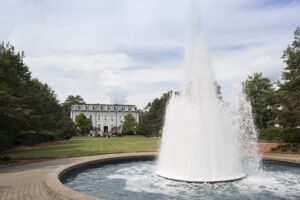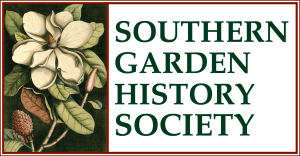
Credit: Photograph by James R. Lockhart, courtesy Staci L. Catron.
The previous Gardens page post discussed the early days of the University of Georgia (UGA) campus, focusing on the quadrangle between Old College and Broad Street in Athens that developed during the Federal era and antebellum years. It was a spot visited and appreciated by Society members during our 2008 Athens-based annual meeting following a talk by historian John Waters. As early University leaders populated these acres with an array of buildings that belonged stylistically within the architectural trends of their day, attention to grounds design was minimal, seeming to involve little more than the surveying needed to properly position new structures. Features such as fences served chiefly as livestock barriers, though a late-antebellum iron fence bordering Broad Street was certainly a nod towards current fashion.
The second half of the nineteenth century would see not only further building activity at UGA but also the advent of expanded thinking about campus landscape design. A milestone came with the 1874-1875 construction of Moore College (now Moore Hall) and the new thinking that this engendered about its surrounding grounds.* Funded in part by the city of Athens as encouraged by university trustee Richard Moore, the building was sited just west of the Chapel and looked north to Broad Street. It would house the State College of Agriculture and Mechanical Arts, thus reflecting UGA’s new status as a land grant institution. Promoting and facilitating this landscape focus were Athens judge Young Harris, local horticulturist and agriculture specialist John Armstrong Meeker, and Prosper Berckmans of Augusta’s Fruitlands Nursery. The enduring result are the ca. 1875-1880 terraces north of Moore Hall. Along with some surviving early trees, they form central elements of the park-like area near the corner of Broad and Lumpkin Streets at the northwest corner of campus.**
Progressing into the twentieth century with chancellor Walter Hill at the helm, UGA embraced new approaches to overall campus design by accepting a bold 1905 master plan prepared by Charles Wellford Leavitt. A New York-based landscape architect and civil engineer, Leavitt had completed an impressive range of public and private commissions prior to undertaking the Athens project, his work joining that of other practitioners of the era in revealing the influence of Beaux Arts Classicism and the City Beautiful movement. While Leavitt’s recommendation to remove Old College to allow for a grander sweep of the North Campus quad was not implemented, many of his ideas and proposals have carried great influence of subsequent decades. (The chapel he proposed to anchor the grand quadrangle he envisioned once Old College was removed ultimately was to become the Main Library.) For its comprehensive nature and long-term impact, Leavitt’s work has been termed by Baltimore architects and campus planners Ayers/Saint/Gross to be “the most significant formal plan in the University of Georgia’s history.”***
As the years passed, however, it was to be a native Georgian and UGA graduate whose name became synonymous with landscape design as well as pedagogy at the university. In 1928, only two years after earning his B.S. degree, Hubert Bond Owens established UGA’S program in landscape architecture. For nearly a decade Owens was the sole instructor there, bringing to his students the knowledge he had garnered not only in Athens but also through studies at Harvard and Cornell. Accepting private commissions also further honed his talents. Many readers will know that over time Owens’ department would expand to become today’s UGA’s College of Environment and Design (CED) and that his talents would find an outlet in a variety of campus projects, including the Founders Memorial Garden and the now-threatened President’s House garden. Toured by SGHS members in 2008, these two important Owens-designed gardens will be discussed in future posts.
For our Society, the legacy of Hubert Bond Owens has been especially evident in the role graduates of the program he founded have played over SGHS’s history. Numbering in this group are Past-Presidents Duncan Callicott, Catherine Howett, Ben Page, Gordon Chappell, and Jim Cothran. Though not a UGA graduate, Past-President Jeff Lewis taught horticulture there, along with serving in Athens as director of Georgia’s State Botanical Garden. Beyond their services to SGHS, these fellow members have also built sterling individual records as practicing landscape architects, historic site professionals, educators, and/or authors who have helped to widen greatly our knowledge about gardens of the past. As well, Duncan Callicott served as UGA’S first official landscape architect, to be followed in later years by Gordon Chappell. Both Gordon Chappell and Jeff Lewis, moreover, remain involved as honorary Society board members.
Unfortunately, space does not allow for reference to other past board members with UGA/CED ties, not to mention members in general with such links. It should be noted, however, that our current board of directors includes CED graduate Thomas Baker, CED graduate and 2014 James R. Cothran Scholarship winner Adam Martin, and UGA horticulture Professor Emeritus Tim Smalley, who has listed “historic gardens” among his areas of teaching emphasis.
********************************************************************
*As in the previous post, readers are directed to Staci Catron and Mary Ann Eaddy’s Seeking Eden along with the links below for details. The campus maps found at this linked site is useful in understanding any discussing of UGA grounds development: https://www.architects.uga.edu/sites/default/files/documents/field/maps/11x17campusmap.pdf
**Further details on the 1870s campus developments, including the terraces north of Moore Hall, and the people in leadership roles, see:
https://www.architects.uga.edu/home/historic-preservation/hpmp-galleries/candler-hall
https://www.architects.uga.edu/home/historic-preservation/hpmp-galleries/moore-college
See the following for more on horticulturist John Meeker:
https://athenshistorical.org/wp-content/uploads/2023/09/AHS-Historian-vol-17-2017-r.pdf
***For more on Leavitt’s work and an expanded historical review of campus planning, see:

Leave a Reply